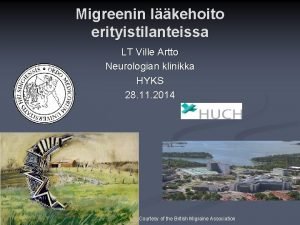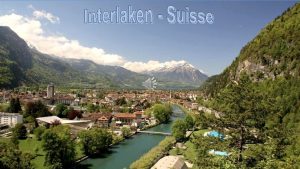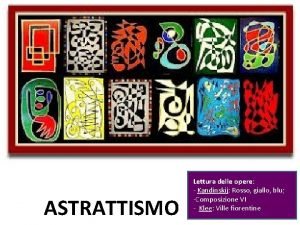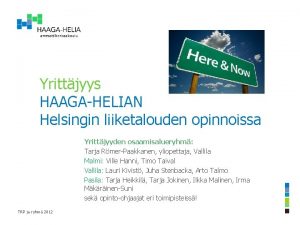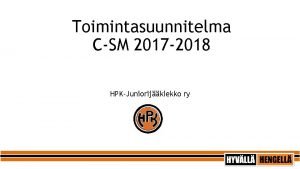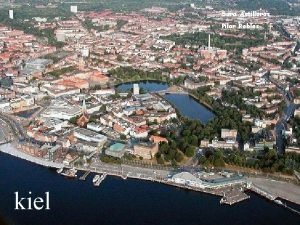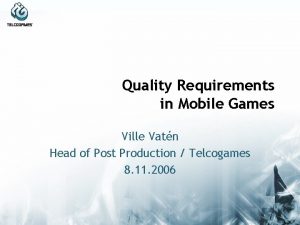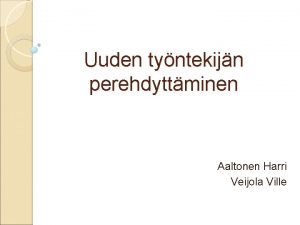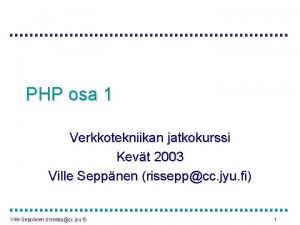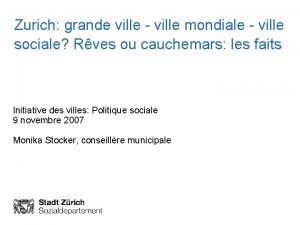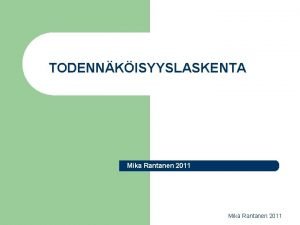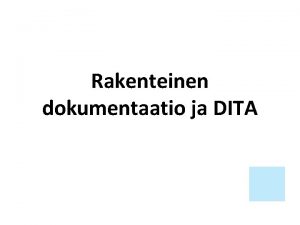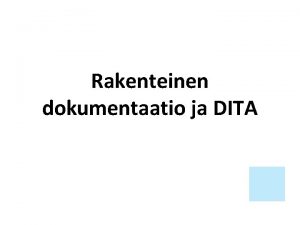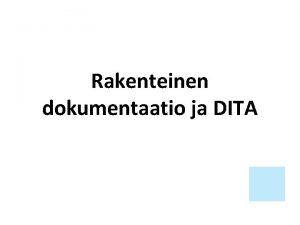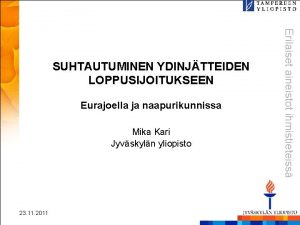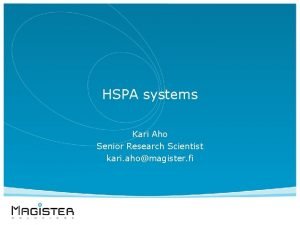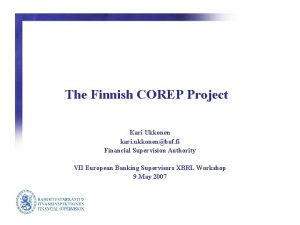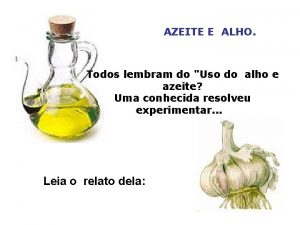Kari E O Alho Ville Kaitila and Mika

























- Slides: 25

Kari E. O. Alho*, Ville Kaitila** and Mika Widgrén*** Speed of Convergence and Relocation: New EU Member Countries Catching up with the Old**** * ETLA and University of Helsinki ** ETLA *** Turku School of Economics, ETLA, CEPR and Ces. Ifo **** ETLA DP No. 963, ENEPRI WP No. 34 May 2005

Background and motivation • Convergence of the new EU member countries (NMCs) is vital for the homogeneity of the EU – How fast and – How sustainable is the convergence process, both in real and nominal terms? • There are fears of relocation of production and jobs from the EU-15 to the NMCs

Aims to analyse • The real and nominal convergence of the NMCs (ACCs) towards the EU-15: – – – Real income Consumption Price level Wage level Balassa-Samuelson framework with several extensions • The impact of this process, through relocation, on the EU -15: – In terms of GDP – National income – Aggregate growth model

Figure 1 Real convergence: GDP per capita (PPP) in the NMCs, EU-15 = 100 Source: European Commission

Figure 2. Nominal convergence: Price level (ratio of current exchange rate to PPP exchange rate) in the NMCs, EU-15 = 100 Source: International Monetary Fund, World Economic Outlook Database

Building a dynamic CGE model for convergence • A model for the new member countries (NMC) – Two sectors, open and sheltered – Introduction of the basic message from empirical convergence literature: growth rate decelerates as convergence proceeds, see below – Capital accumulation in the open sector through partial adjustment – A combination of forward-looking and liquidity-constrained consumption behaviour – International labour mobility based on existing gap in real wages – Inflow of FDI has a spillover effect on domestic TFP, endogenous growth • A model for EU-15 – Outflow of capital through FDI flows into the NMCs, motivated by outsourcing of production to low cost NMCs – Utilisation of this gain in competitiveness in EU-15 production – Budgetary transfers between the EU-15 and NMCs through the EU budget • Both regions are open to the world economy, the convergence process does not have an influence on the global prices or interest rates

Combining the basic message of convergence to the model: Let us fix the long-run equilibrium: at time T QT = QT* and g. T = g. T* This calibrates the parameters β 0 and β 1, given the initial growth rate g and g*, and the initial ratio of income levels. Let productivity growth in the open sector be 6% and the sheltered sector be 4. 5% p. a.

The basic Balassa-Samuelson framework combined with beta convergence

Combining uncertainty with the basic B-S framework

Specification of a CGE model • Endogenous growth in NMCs: TFP growth in the NMCs is a function of FDI inflows

The human capital/income in NMCs and relative income in NMCs in ratio to EU-15 Aggregate consumption: sum of that of liquidity (income) constrained and forward-looking consumers

The model for EU-15 where Q* = gross prod Y* = value added M = imported intermed. goods Outsourcing improves the profitability of EU production So technology is in this sense endogenous. The FDI is determined through a portfolio balance equation, Actual Kfdi follows then through partial adjustment

Two scenarios • Baseline: no further FDI inflows from the EU-15 into the NMCs • Alternative scenario 1, vigorous FDI inflows so that the stock of FDI of the EU-15 firms in the NMCs grows sixfold in 30 years. • Time span: 2000 -2030 • Forward-looking consumption behaviour for a part of the NMC consumers

Growth rate in the NMCs in the two scenarios

The inflation rate

The rate of rise of the wage rate, per cent

The total labour force (Lacc), labour in the open (L open) and sheltered (Lshel) sectors in NMCs in the high FDI scenario

Impact on welfare, consumption in scenario 1 / baseline

Foreign debt in NMCs in relation to GDP

Foreign debt /GDP, with share h of forward-looking consumers being 50%

Rate of return in NMCs in the baseline scenario and the high FDI inflow scenario 1

Real and nominal convergence in the high FDI scenario, NMCs / EU-15

GDP, the real wage, National Income and Income of incumbent EU-15 nationals, endogenous FDI (scenario 1) in relation to baseline of fixed stock of inward FDI

Decomposition of difference, %, in EU-15 GDP between the scenarios

Policy questions raised by the model • Inflation in NMCs seems to be quite a persistent problem, average 4% p. a. ? • Foreign indebtedness a looming problem if a vigorous growth continues? • Outsourcing not a problem for the EU-15 in a GE sense? Of course, this depends on the magnitude of the shock, but it was in the simulation quite sizeable in itself. • There is a polarising outcome with respect to further integration in the EU-15.
 Paris ville mondiale bac pro
Paris ville mondiale bac pro Candesartan migreeni kokemuksia
Candesartan migreeni kokemuksia Ville troglodyte pouilles
Ville troglodyte pouilles Pianta insula romana
Pianta insula romana Jeff barrett musician
Jeff barrett musician Interlaken ville
Interlaken ville Allons en ville chapitre 9 vocabulaire 1
Allons en ville chapitre 9 vocabulaire 1 Ville fiorentine klee
Ville fiorentine klee Kimmo greis
Kimmo greis Ville radieuse plan
Ville radieuse plan Ville turjanmaa
Ville turjanmaa Ma ville vocabulaire
Ma ville vocabulaire Bearville city
Bearville city Saint etienne ville moche
Saint etienne ville moche En terme de contenu
En terme de contenu Ville intelligente ppt
Ville intelligente ppt New york une ville mondiale
New york une ville mondiale College ville d avray
College ville d avray Ville kautiainen
Ville kautiainen Ville dallemagne
Ville dallemagne Ville gaming genre
Ville gaming genre Harri veijola
Harri veijola Raconte ta ville
Raconte ta ville Ville seppänen jyu
Ville seppänen jyu Kjennetegn novelle
Kjennetegn novelle Lycée camille claudel mantes
Lycée camille claudel mantes

